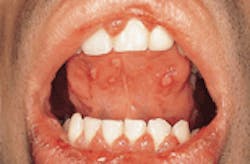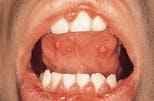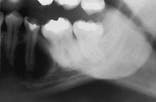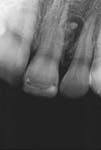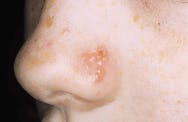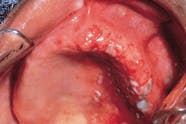Case Study Test
A variety of topics were presented in the 1997 Case Study columns. The following 44 questions will allow you to review the year`s columns and determine your diagnostic skills. After completing the Case Study Test, turn to page 33 to check your answers.
Joen Iannucci Haring, DDS, MS
Case 1
Acute Herpetic Gingivostomatitis
1. Identify which of the following remain in the host body after the initial infection with the herpes simplex virus (HSV):
a. HSV antibodies only
b. HSV only
c. Both HSV antibodies & HSV
d. Neither HSV antibodies nor HSV
2. Identify which of the following signs and symptoms are characteristic of acute herpetic gingivostomatitis that is subclinical:
a. Fever and malaise
b. Multiple oral lesions
c. Crusted lip lesions
d. No clinical signs or symptoms
3. Identify the location(s) of the oral lesions seen with acute herpetic gingivostomatitis:
a. Attached mucosa
b. Unattached mucosa
c. Vermilion of the lips
d. Any of the above
4. Identify the method(s) used to diagnosis acute herpetic gingivostomatitis:
a. Cytologic smear techniques
b. Viral culture
c. Serologic testing
d. Any of the above
Case 2
Gemination
1. Identify the most common location for a geminated tooth:
a. Incisor and canine area
b. Premolar area
c. Molar area
d. Ramus
2. Identify the most likely radiographic appearance of a geminated tooth:
a. Large crown with one root and one pulp canal
b. Large crown with two roots and two pulp canals
c. Either of the above
d. None of the above
3. Identify the treatment for a geminated tooth:
a. Extraction
b. Root canal therapy
c. Restorative treatment
d. Either a or c
4. Identify the dental anomaly that may be confused with gemination:
a. Fusion
b. Taurodont
c. Concrescence
d. All of the above
Case 3
Hypercementosis
1. Identify the most common tooth affected by hypercementosis:
a. Incisors
b. Premolars
c. Molars
d. Canines
2. Identify the radiographic appearance of hypercementosis:
a. Roots appear enlarged and bulbous
b. Roots appear abnormally small
c. Roots appear blunted and resorbed
d. None of the above
3. Identify the treatment for hypercementosis:
a. Extraction
b. Root canal therapy
c. Restorative treatment
d. No treatment required
4. Identify which of the following is associated with hypercementosis:
a. Paget`s disease
b. Cherubism
c. Fibrous dysplasia
d. Osteopetrosis
Case 4
Ossifying Fibroma
1. Identify the most common location for the ossifying fibroma:
a. Mandibular premolar-molar area
b. Mandibular incisor-canine area
c. Maxillary premolar-molar area
d. Maxillary incisor-canine area
2. Identify the most likely radiographic appearance(s) of the ossifying fibroma:
a. Unilocular radiolucency
b. Multilocular radiolucency
c. Dense radiopacity
d. Both a & c
3. Identify the treatment for the ossifying fibroma:
a. Radiation therapy
b. Antibiotic therapy
c. Surgical enucleation
d. None of the above
4. Identify the average age range of an individual with an ossifying fibroma:
a. First and second decades
b. Second and third decades
c. Third and fourth decades
d. Fourth and fifth decades
Case 5
Palatal Cysts of the Newborn
1. Identify the most common location for palatal cysts of the newborn:
a. Gingiva
b. Alveolar mucosa
c. Tongue
d. Hard and soft palates
2. Identify the origin of the palatal cysts of the newborn:
a. Reactive
b. Neoplastic
c. Developmental
d. Viral
3. Identify the percentage of newborns with palatal cysts:
a. 15 to 35 percent
b. 25 to 45 percent
c. 65 to 85 percent
d. 75 to 95 percent
4. Identify the treatment for palatal cysts of the newborn:
a. Surgical removal
b. Antibiotic therapy
c. Curettage
d. No treatment required
Case 6
Herpetiform RAU
1. Herpetiform recurrent aphthous ulcers (RAU) are often misdiagnosed as:
a. Acute herpetic gingivostomatitis
b. Recurrent herpes labialis
c. Recurrent intraoral herpes
d. None of the above
2. Identify the location of herpetiform RAU:
a. Attached mucosa
b. Unattached mucosa
c. Vermilion of the lips
d. Both attached and unattached mucosa
3. Identify the normal healing time for herpetiform RAU:
a. One to two weeks
b. Under one week
c. Four to six weeks
d. Longer than six weeks
4. Identify the number of clinical forms of RAU:
a. One
b. Two
c. Three
d. Four
Case 7
Calcifying Odontogenic Cyst
1. Identify the most common location for the calcifying odontogenic cyst (COC):
a. Incisor and canine area
b. Premolar area
c. Molar area
d. Ramus
2. Identify the radiographic appearance(s) of the COC:
a. Unilocular radiolucency
b. Multilocular radiolucency
c. Mixed lucent-opaque
d. Both a & c
3. Identify the treatment for the COC:
a. Radiation therapy
b. Antibiotic therapy
c. Surgical enucleation
d. None of the above
4. Identify the average age of an individual with a COC:
a. Mid-teens
b. Mid-twenties
c. Mid-thirties
d. Mid-forties
Case 8
Keratoacanthoma
1. Identify the most common location for the keratoacanthoma:
a. Sun-exposed skin
b. Skin of the trunk
c. Gingiva
d. Hard and soft palates
2. Identify the origin of the keratoacanthoma:
a. Reactive
b. Neoplastic
c. Developmental
d. Viral
3. Identify the typical age of a person with a keratoacanthoma:
a. 10 to 20
b. 20 to 30
c. 30 to 40
d. Over 45
4. Identify the recommended treatment for the keratoacanthoma:
a. Surgical removal
b. Antibiotic therapy
c. Curettage
d. No treatment required
Case 9
Erythema Migrans
1. Identify the most common location(s) for erythema migrans:
a. Tongue
b. Buccal and labial mucosa
c. Soft palate
d. All of the above
2. Identify the origin of erythema migrans:
a. Reactive
b. Fungal
c. Developmental
d. Unknown
3. Identify the typical age of a person with erythema migrans:
a. 20 to 30
b. 30 to 40
c. 40 to 50
d. Any age group
4. Identify the treatment for erythema migrans:
a. Surgical removal
b. Antibiotic therapy
c. Antifungal therapy
d. No treatment required
Case 10
Primary Varicella Zoster
1. Identify the true statement concerning primary varicella zoster (chickenpox):
a. May occur more than once
b. Is highly contagious
c. Affects children only
d. Occurs most often in summer
2. Identify the percentage of people in the United States that have a history of chickenpox:
a. 95 percent
b. 85 percent
c. 75 percent
d. 50 percent
3. Identify the signs and symptoms that are characteristic of chickenpox:
a. Rash, fever, malaise, headache
b. Unilateral lesion distribution
c. Prodromal pain and burning
d. Pain, swelling and fever
4. Identify the location(s) of lesions seen with chickenpox:
a. Skin of trunk
b. Skin of face
c. Oral mucosa
d. All of the above
Case 11
Secondary Varicella Zoster
1. Identify the stimulant(s) that reactivate the varicella zoster virus (VZV) and cause shingles (secondary varicella zoster):
a. Immunosuppression
b. Old age
c. Dental trauma
d. All of the above
2. Identify the percentage of people in the United States that have a history of chickenpox and experience shingles:
a. 0 to 10 percent
b. 10 to 20 percent
c. 20 to 30 percent
d. 40 to 50 percent
3. Identify the prodromal sign(s) and symptom(s) that may occur prior to the appearance of shingles:
a. Burning
b. Tingling
c. Pain
d. All of the above
4. Identify the most common location(s) of lesions seen with shingles:
a. Skin of trunk and face
b. Skin of arms and legs
c. Skin of head and neck
d. Skin of trunk only
Case Study Test Answers
Case 1:
1 = c
2 = d
3 = d
4 = d
Case 2:
1 = a
2 = a
3 = d
4 = a
Case 3:
1 = b
2 = a
3 = d
4 = a
Case 4:
1 = a
2 = a
3 = c
4 = c
Case 5:
1 = d
2 = c
3 = c
4 = d
Case 6:
1 = a
2 = d
3 = a
4 = c
Case 7:
1 = a
2 = d
3 = c
4 = c
Case 8:
1 = a
2 = d
3 = d
4 = a
Case 9:
1 = d
2 = d
3 = d
4 = d
Case 10:
1 = b
2 = a
3 = a
4 = d
Case 11:
1 = d
2 = b
3 = d
4 = a
Joen Iannucci Haring, DDS, MS, is an associate professor of clinical dentistry, Section of Primary Care, The Ohio State University College of Dentistry.
